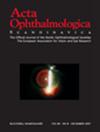Endothelial cell heterogeneity in arteriolar annuli: Implications in retinal blood flow regulation
Abstract
Aims/Purpose: To investigate the endothelial cell heterogeneity in retinal arterioles with special focus in arteriolar annuli.
Methods: We compared structural and molecular characteristics between endothelial cells located in arteriolar annuli and endothelial cells located in other regions of retinal arterioles. Immunohistochemical, histochemical, and electron transmission microscopy assays were performed.
Results: Molecular analysis showed that arteriolar annuli endothelial cells showed a decreased expression of PECAM-1 together with an increased expression of NADPH-diaphorase in comparison with other regions of retinal arterioles. PECAM-1 is involved cell-cell adhesion. Therefore, this result suggests a decrease in cellular adhesion at the arteriolar annuli. NADPH diaphorase reflects nitric oxide synthase activity. Thus, its increase indicates NO synthesis suggesting localized vasodilation and decrease of platelet aggregation at arteriolar annuli. An increased expression of von Willebrand factor in concomitance with a higher presence of Weibel-Palade bodies was also observed in endothelial cells at the arteriolar annuli, suggesting that von Willebrand factor is stored and released in a regulated manner. Furthermore, transmission electron microscopy showed the presence of two endothelial cell subtypes in arteriolar annuli: activated endothelial cells, and shear stress-adapted endothelial cells. Activated endothelial cells exhibited enlarged nuclei with chromatin condensed in the periphery, swollen perinuclear space, and an increased number of vesicles and caveolae. By contrast, shear stress-adapted endothelial cells were thicker than the rest of endothelial cells and showed bilobulated nuclei, a well-developed endoplasmic reticulum, as well as large increase in the number of mitochondria.
Conclusions: All our results suggest that endothelium at arteriolar annuli, a structure suggested to regulate retinal blood flow by exerting a sphincter-like activity, is formed by a subset of endothelial cells endowed with distinctive structural and molecular features which allow them to play a key role in the maintenance of blood flow through two mechanisms: the establishment of an antithrombotic milieu, and the vasodilation of arteriolar annuli.

 求助内容:
求助内容: 应助结果提醒方式:
应助结果提醒方式:


